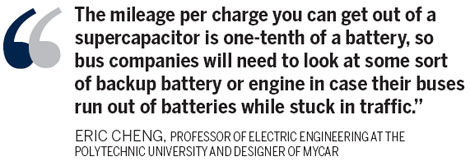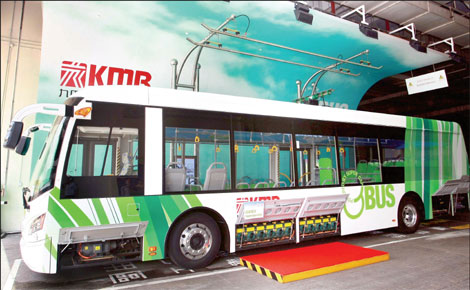Zero-emission bus goes on trial on city streets
Updated: 2010-09-15 07:14
By Timothy Chui(HK Edition)
|
|||||||
|
Hong Kong's first green bus, the gBus, is ready for a six-month trial at the Kowloon Motor Bus depot Tuesday. The bus can run continuously for five kilometers. Edmond Tang / China Daily |
A franchised bus company has introduced Hong Kong's first supercapacitor bus. The challenge for the zero-emission, energy-efficient bus is to be able to adapt to the city's steep, winding, and at times, congested roadways.
Rolling out of the Kowloon Motor Bus' (KMB) Lai Chi Kok bus depot Tuesday, the 12-meter 70-person capacity "gBus" can run continuously for five kilometers, roughly the distance between Tsim Sha Tsui and Sham Shui Po.
Unlike Hong Kong Island's tramline, the supercapacitor bus does not require overhead cables to operate. It can take on a charge sufficient to travel 1 kilometer in roughly 30 seconds.
"The technology is especially well suited for bus operations, which typically require frequent stops at relatively short distances," KMB Managing Director Edmond Ho said.
The trials will cover routes between Lai Chi Kok depot and Mei Foo and will cover pressure tests under hot and wet weather conditions, loading and reliability tests.
Supercapacitor buses that create no roadside emissions have been on trials in Shanghai for four years.
Polytechnic University professor of electrical engineering and designer for the globally acclaimed electric MyCar Eric Cheng said supercapacitor technology was especially well suited for Hong Kong's roads but warned the newer technology carries double the cost of battery-based technologies.
"The major advantage is that supercapacitors have a very long life time. Batteries wear down after 5,000 charges while you can recharge a supercapacitor 500,000 times or more. This translates into lower operating maintenance," he said.
While batteries contained both liquid and solid components along with dangerous heavy metals that are problematic during disposal, the inside of supercapacitors resembled a Blackforest cake-like filler, without the frosting, made up of inert carbon nano-fibers with two metal poles like traditional batteries.
Aside from being safer, supercapacitors hold a larger current, making for faster recharge times and better energy recovery from braking.
Its large capacity also made it more efficient for tackling steep slopes when compared with battery power, but its high voltage also meant supercapacitors needed more frequent charging.
"The mileage per charge you can get out of a supercapacitor is one-tenth of a battery, so bus companies will need to look at some sort of backup battery or engine in case their buses run out of batteries while stuck in traffic. Otherwise they'll need a tow or at the very least need to turn off the air conditioning," he said.
Overhead charging stations could be placed at bus stops near pedestrian flyovers, but charging stations would be at least twice as expensive as current electric vehicle charging stations designed for battery powered electric cars, Cheng said.
China Daily

(HK Edition 09/15/2010 page1)
